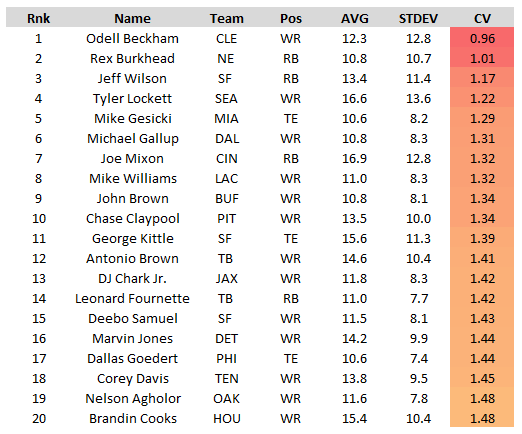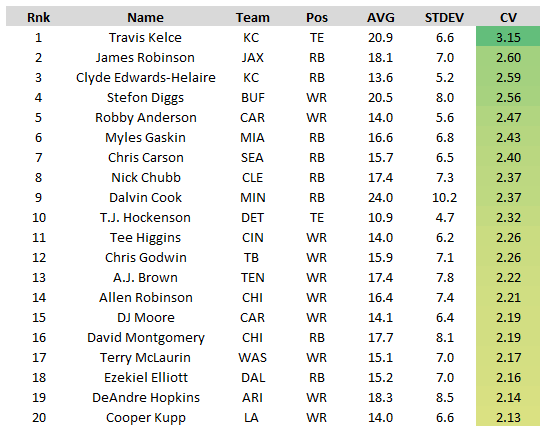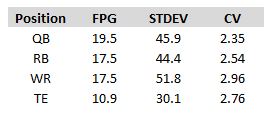You’ll notice that our best ball rankings look quite a bit different than our season-long projections. That’s due primarily to one thing: week-to-week consistency.
Over the past two seasons, Tyler Lockett ranks 7th among wide receivers in total fantasy points, averaging 16.2 FPG. He played in 32 games but scored 43% of his total fantasy points in just six of those games (19% of his total games). Outside of these games, Lockett averaged just 10.9 fantasy points per game. For perspective, that would have been the difference between finishing 14th and 59th among wide receivers in FPG last year. Or, rather, that’s the difference between Lockett being a treasured fantasy asset and worthless waiver-wire fodder.
An even better example is T.Y. Hilton. According to ESPN, when Hilton was started in over 50% of leagues last season, he averaged just 6.1 FPG. And among his nine most-started weeks, Hilton averaged just 5.9 FPG with a high of only 9.9 fantasy points. But across his six least-started weeks, he hit highs of 23.1, 21.0, and 16.1. Basically, Hilton was highly volatile and nearly impossible to predict week-to-week. So, in a start/sit league, Hilton was worse than useless, only ever returning negative value to your team – when you played him, he killed you, and when you sat him, he went off. It’s not hard to see why predictability and week-to-week consistency are so important in start/sit leagues. But in best ball leagues, Hilton was far more valuable.
In best ball leagues, volatility is your friend — there are no start/sit decisions and your highest-scoring players automatically slide into your starting roster at the end of the week. It’s no surprise then that Lockett and Hilton rank much higher in our best ball rankings than in our projections.
With Lockett, Hilton, and best ball leagues in mind, I wanted to look at 2020’s least and most consistent scorers for fantasy.
Tristan Cockroft does this every year for ESPN, as does John Paulsen for 4for4. I’m going to approach this in a similar way to Paulsen. We’ll be looking at every player’s numbers in every week over the course of a full season. We’ll then calculate a player’s standard deviation to determine how much variation there was in their fantasy scoring on a week-to-week basis. Then, we’ll standardize these scores across scale by dividing a player’s fantasy points per game into his standard deviation, to determine that player’s coefficient of variation (CV).
Among all non-QBs (min. 10.5 fantasy points per game), here were last season’s 20 least and then most consistent fantasy scorers by coefficient of variation:
(This is our first look at fantasy consistency, looking at consistency by fantasy points scored. It’s a good starting point, but with fantasy points so dependent on touchdown luck/variance, I don’t know that it’s the superior methodology. Instead, I think the better approach is measuring consistency by role and usage. Lucky for you, that’s exactly what we’ll be doing in tomorrow’s article.)
Most Inconsistent
- Odell Beckham saw consistent usage to start the season, earning between 6 and 10 targets in 5 of his 6 healthy games, but his production was far less consistent. He averaged 14.4 FPG across those six games, but only 9.5 if we exclude a monster 38.4-point performance in Week 4. Following myriad injuries, Beckham is a tricky evaluation as he enters his age 29 season on the run-first Browns. Color me mostly skeptical — he has just two 100-yard games since 2018.
- Although no one ever played him, Jeff Wilson did post some monster boom-weeks for fantasy. He hit highs of 32.0 fantasy points (Week 7), 27.4 (Week 16), 24.0 (Week 3), and 23.8 (Week 17). With Wilson on the PUP list to start the year, these sort of boom weeks are an added reason to love Raheem Mostert and Trey Sermon in best ball leagues. But the lack of consistency (Wilson fell short of 8.0 fantasy points in 45% of his games) is a reason to devalue both running backs in redraft leagues.
- For the second straight season Lockett ranks as one of fantasy football’s top-5 most inconsistent players. Last season, 46% of his total fantasy points came in just three of his 16 games (19%). In 2019, 42% of his production came in just three (19%) of his 16 games. And he's been equally as inconsistent in usage. Over the past two seasons, he's seen double-digit targets only six times, averaging 15.7 targets per game in those games, but just 5.7 targets per game the rest of the time (which would have ranked 57th among wide receivers last year). I think this is just sort of who Lockett is, and who he’s going to be again in 2021. For that reason, he’s another player more valuable in best ball leagues.
- Mike Gesicki was technically inconsistent last year, but I'm not penalizing him for that. He was actually consistently underwhelming in the first half of the season and consistently valuable in the second half of the year. He averaged 15.6 FPG over his final five games but only 8.1 FPG to start the year. That's encouraging for his prospects in 2021, as is the fact that he was QB Tua Tagovailoa’s most-targeted receiver in games active (16.3% target share), but there's also a lot more target competition in Miami this year.
- It’s no surprise to see a number of high-aDOT deep threats make this list — Nelson Agholor (15.3 aDOT), Mike Williams (15.0), D.J. Chark (14.0), Chase Claypool (13.1) — as they’re naturally going to be more inconsistent on a week-to-week basis. The bulk of their production comes on deep targets — a high-upside/low-probability play — which means big games when they’re coming down with those targets and plenty of dud-games when they don’t. In general, yes, wide receivers who specialize in deep targets are going to be more valuable in best ball than in start/sit leagues.
- Joe Mixon has been wildly inconsistent in each of the past three seasons. But that’s only true based on CV. In actuality, Mixon is wildly consistent, just highly gamescript-dependent. Which is to say, he’s consistently great in games Cincinnati wins and consistently underwhelming in games Cincinnati loses. Over the past three seasons, he averages 11.9 more FPG in victories (25.2 FPG) than losses (13.3). However, now that RB Giovani Bernard is gone, and Mixon is staring a bell cow workload, I think we’ll see Mixon be highly consistent and consistently hyper-productive in 2021.
Most Consistent
- Travis Kelce was absurd in 2020, averaging 20.9 FPG, or the most by any tight end in any season ever. By fantasy WAR, he was the third-most valuable player in PPR leagues last year. In addition, he was far-and-away the most consistent player in fantasy, scoring between 14.7 and 27.6 fantasy points in 13 of 15 games. Although we’ve conceded a lack of consistency makes a player less valuable in start/sit leagues in comparison to best ball, Kelce is probably still more valuable in best ball leagues. I talked about this in more detail here, but the short of it is, drafting Kelce means fewer additional resources needed to spend on tight ends, means more resources to spend at other positions, means an amplified positional advantage (to, already, the biggest positional advantage in fantasy football). Here’s the example I used:
Kelce scored 315 fantasy points in BestBall10s last year. That was almost exactly double the 7th-highest scoring tight end over this span. The No. 3, No. 4, and No. 5 highest-scoring tight ends combined to score 532 fantasy points. But, if in a best ball format (taking the higher score in each week), and if treated as one player, they combined to score just 259 fantasy points. Of course, we're neglecting any points one of these tight ends might have scored in the flex. But still, this is absurd. At the tight end spot, Kelce alone (bye week factored) was 22% more valuable than the No. 3, No. 4, and No. 5 highest-scoring tight end combined. Factor in draft capital – one Round 2 pick vs. 3 mid- to later-round picks – and it’s clear, Kelce was a massive cheat code in best ball. WAR expert Jeff Henderson would argue (and will in a forthcoming piece) Kelce is legitimately in play as a top-3 overall pick in 2021 best ball drafts.
- The only other actionable takeaway from this chart (for me), was that it was somewhat surprising to see some of the names of the running backs who made this list. It might be irrelevant for 2021, but it’s highly impressive to see James Robinson make this list. Despite a massive gamescript disadvantage on the one-win Jaguars, Robinson ranked third in touches per game (20.6), behind only Dalvin Cook and Derrick Henry. With Travis Etienne likely keeping him off the field on passing downs this year, expect him to be a lot less consistent (week-to-week) and far more gamescript-dependent.
- Clyde Edwards-Helaire was a surprise, but I think the takeaway here is just that he wasn’t really affected by touchdown variance (which is always a huge factor), mainly because he didn’t score very many of them.
- Nick Chubb was a surprise because he’s not a bell cow (defined here). Typically the most consistent fantasy running backs are bell cows, and the most inconsistent running backs are those stuck in committee backfields. But with Cleveland leaning so massively run-heavy (48%, 4th-most), and with Chubb being the hyper-efficient freak that he is, and with Cleveland sporting PFF’s top-graded OL in run blocking, he needs to be viewed as a sort of Derrick Henry-esque outlier for fantasy.
Positional Consistency
Finally, as a bonus aside, I wanted to look at positional consistency. Looking only at the 20 highest-scoring players at each position, here’s how each position fared in terms of coefficient of variation over the past three seasons. The QB position was the most consistent, followed by RBs, then TEs, and then WRs.
I talk about all this in more detail in my Best Ball Primer & Strategy Guide.










